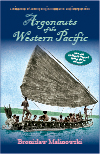“This is a classic piece and one of the most important ethnographies ever written. Your paperback edition was well crafted and particularly fine for students that are being first exposed to the discipline.” — Juan J. Gutierrez, California State University, Monterey Bay
“Thank you for this. The new digital reproductions are indeed important and affective because the photo plates are so integral to Malinowski’s ethnographic analysis. I teach this book every year and know that next fall’s students will appreciate the improvement.” — William W. Kelly, Yale University

527 pages, $40.95 list
1-4786-0209-0
978-1-4786-0209-5
© 1922
paperback
eBook availability
Argonauts of the Western Pacific
An Account of Native Enterprise and Adventure in the Archipelagoes of Melanesian New Guinea, Enhanced Edition
Enhancedth Edition
Bronislaw Malinowski had a talent for bringing together in single comprehension the warm reality of human living with the cool abstractions of science. His pages have become an almost indispensable link between the knowing of “exotic” and remote people and theoretical knowledge about humankind.
This classic volume—originally published in 1922—can be considered the founding document of economic anthropology, and remains the best one to read. It emphasizes the great significance of “primitive” economics by singling out the notable exchange system of the Trobriand Islands for special consideration. Although the main theme is economic, constant reference is made to social organization, life and meaning, the power of magic, and mythology and folklore.
Following Malinowski, we are soon “paddling on the lagoon, watching the natives under the blazing sun at their garden work, following them through the patches of jungle. And on the winding beaches and reefs, we shall learn about their life.” The life we learn about is both Trobriand life in New Guinea as well as life of common humanity.
For nearly thirty years, Waveland Press has made Malinowski’s most famous ethnography available for modern-day students and readers at a reasonable price. Both the current print version and the ebook have been greatly enriched by 80 digitally enhanced historic photographs and maps.
This classic volume—originally published in 1922—can be considered the founding document of economic anthropology, and remains the best one to read. It emphasizes the great significance of “primitive” economics by singling out the notable exchange system of the Trobriand Islands for special consideration. Although the main theme is economic, constant reference is made to social organization, life and meaning, the power of magic, and mythology and folklore.
Following Malinowski, we are soon “paddling on the lagoon, watching the natives under the blazing sun at their garden work, following them through the patches of jungle. And on the winding beaches and reefs, we shall learn about their life.” The life we learn about is both Trobriand life in New Guinea as well as life of common humanity.
For nearly thirty years, Waveland Press has made Malinowski’s most famous ethnography available for modern-day students and readers at a reasonable price. Both the current print version and the ebook have been greatly enriched by 80 digitally enhanced historic photographs and maps.
Reactions
Preface by Sir James G. Fraser
Introduction. The Subject, Method and Scope of This Enquiry
1. The Country and Inhabitants of the Kula District
2. The Natives of the Trobriand Islands
3. The Essentials of the Kula
4. Canoes and Sailing
5. The Ceremonial Building of a Waga
6. Launching of a Canoe and Ceremonial Visiting—Tribal Economics in the Trobriands
7. The Departure of an Overseas Expedition
8. The First Halt of the Fleet on Muwa
9. Sailing on the Sea-Arm of Pilolu
10. The Story of Shipwreck
11. In the Amphletts—Sociology of the Kula
12. In Tewara and Sanaroa—Mythology of the Kula
13. On the Beach of Sarubwoyna
14. The Kula in Dobu—Technicalities of the Exchange
15. The Journey Home—The Fishing and Working of the Kaloma Shell
16. The Return Visit of the Dobuans to Sinaketa
17. Magic and the Kula
18. The Power of Words in Magic—Some Linguistic Data
19. The Inland Kula
20. Expeditions Between Kiriwina and Kitava
21. The Remaining Branches and Offshoots of the Kula
22. The Meaning of the Kula
Introduction. The Subject, Method and Scope of This Enquiry
1. The Country and Inhabitants of the Kula District
2. The Natives of the Trobriand Islands
3. The Essentials of the Kula
4. Canoes and Sailing
5. The Ceremonial Building of a Waga
6. Launching of a Canoe and Ceremonial Visiting—Tribal Economics in the Trobriands
7. The Departure of an Overseas Expedition
8. The First Halt of the Fleet on Muwa
9. Sailing on the Sea-Arm of Pilolu
10. The Story of Shipwreck
11. In the Amphletts—Sociology of the Kula
12. In Tewara and Sanaroa—Mythology of the Kula
13. On the Beach of Sarubwoyna
14. The Kula in Dobu—Technicalities of the Exchange
15. The Journey Home—The Fishing and Working of the Kaloma Shell
16. The Return Visit of the Dobuans to Sinaketa
17. Magic and the Kula
18. The Power of Words in Magic—Some Linguistic Data
19. The Inland Kula
20. Expeditions Between Kiriwina and Kitava
21. The Remaining Branches and Offshoots of the Kula
22. The Meaning of the Kula